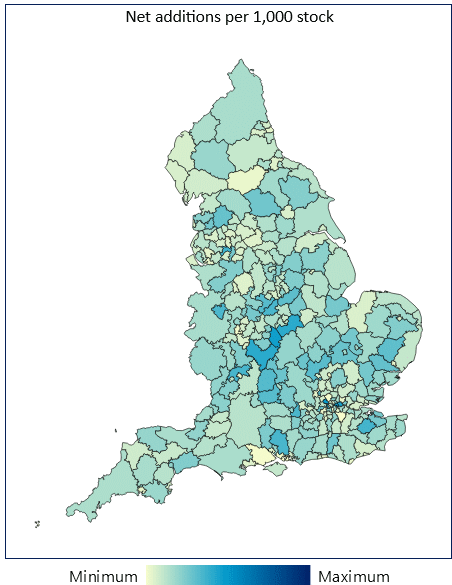Search
Tools to help you make the case for housing development in planning applications and appeals
Planning Decisions all too often refuse small scale residential developments with the (flawed) reasoning that a small number of houses will make little difference to overall supply, so have limited benefit in the planning balance. How can you overcome this?
A related problem is decision makers’ common assumption that the Local Plan makes adequate provision for housing development. Some officers’ reports have even been known to state, “there’s no need for this development”. How can an applicant or appellant challenge this assumption and show a real need for a proposed residential development?
We have put together a toolkit of ideas to help you make your planning case on the need for residential development stronger:
Tool 1: Evidence your planning case with facts and figures

There are too many appeal Decisions where the Inspector dismisses the appeal citing they, “have not been presented with any evidence that the development would address any identified local housing needs”.
Inspectors like evidence. It’s concrete, it’s definitive, and they can quote it in their Decision. If they allow an appeal, they have to provide reasons for coming to a different decision from the local planning authority. Giving the Inspector authoritative evidence gives them the option of finding housing needs have changed and/or should be given greater weight.
Hard facts can be very persuasive, but you may not have the time to find them. To make it quicker, here’s our ready links to useful datasets:
- MHCLG's interactive dashboard provides nice graphs and maps ideal for copying and pasting into planning statements and appeal statements. It's a brilliant tool to create a visual housing delivery message. Or you may prefer to use MHCLG's housing delivery statistics to create a bespoke graph using the net homes delivered figures below:
- Net homes delivered for every year 2000 - 2025 by LPA in table 122.
- Housing Delivery Test results by LPA over the years 2019-2023 (last publishlised by MHCLG on 12/12/2024)
- The local affordability ratio used by the standard method, table 5c in the “House price to workplace-based earnings ratio”.
- Affordable housing evidence including targets, waiting lists, affordable dwelling starts & completions.
Tool 2: Use the smallest scale available

Referring to the missed national target of 300,000 new homes per year is pretty ineffective in winning a planning argument. Housing evidence has to be at the right geographic scale, which means as local as you can get. If you’re really lucky there may be a recent parish or Neighbourhood Plan housing survey, but in most cases the local planning authority area will be the best scale available.
Remember to check the Local Plan evidence base for any recent Housing Market Assessment or similar reports, as these often contain more localised data.
Tool 3: Show how reality squares up with the Plan
 Most decision makers will assume the Local Plan makes adequate provision for housing, which can result in a "we don't need your site" mentality.
Most decision makers will assume the Local Plan makes adequate provision for housing, which can result in a "we don't need your site" mentality.
To demonstrate the Local Plan no longer matches reality on the ground, use up-to-date figures which demonstrate a change since the Local Plan was adopted. For example:
- failure to meet its housing requirements. For a full briefing see our ‘Insider’s Guide to the Housing Delivery Test’.
- worsening affordability, longer housing waiting lists or poor delivery of affordable housing locally. For ideas see ‘winning appeals with good evidence on affordable housing’. Affordable housing is often given special weight in the planning balance, partly because there is such an acute shortage of it, and partly because it helps social and economic sustainability to an even greater degree than market housing.
A simple graph showing the trend since the Local Plan was adopted can draw attention to the fact the area is failing to meet NPPF para 8b which seeks development, “to support strong, vibrant and healthy communities by ensuring that a sufficient number and range of homes can be provided to meet the needs of present and future generations”. In turn this may increase the weight the Inspector gives to housing provision in weighing up the benefits against harms in the planning balance.
It’s also well worth checking the Local Plan evidence base. If the Local Plan is under review, recent reports may contain useful new information.
Tool 4: A picture speaks a thousand words
It’s easy to lose a planning officer or planning inspector with too much detailed argument. Not all are capable of being excited by statistics. You see their eyes glaze over and realise your argument has just gone way over their head. There is a simple answer. Go visual.
“A picture speaks a thousand words” is undoubtedly true when trying to convey housing delivery statistics to planning officers, members on planning committees and Planning Inspectors. Wherever you can, use graphs, use infographics, use headline figures, use simple tables. Use maps. Use comparisons. Often it is the direction of travel, or a comparison with neighbouring areas that communicates most effectively to a decision maker.



Appeal Decisions Online
Planning Appeal Search
- All planning appeals in England since 2010
- Includes all appeals on PINS new website (refs 600XXXX)
- Powerful search with map and advanced searching tools
Easy Cost Effective Access
- Helps you make a stronger case to win planning consent
- Free trial, then a simple Monthly or Annual subscription
- Helpful Blogs, LPA quick links and other Resources
Loved by Customers
Berrys
Loved by the Industry
 Loved by You? Try us and see; FREE for a month.
Loved by You? Try us and see; FREE for a month.
Test our service entirely free for a month. There's absolutely no obligation and there's no payment details required. We're sure you'll be pleasantly surprised, so just complete our Free Trial request form today.
Howie Associates Ltd trading as AppealFinder® Terms & Conditions Cookies Policy Privacy Notice Follow on LinkedIn 
Contains public sector information licensed under the Open Government Licence v3.0



